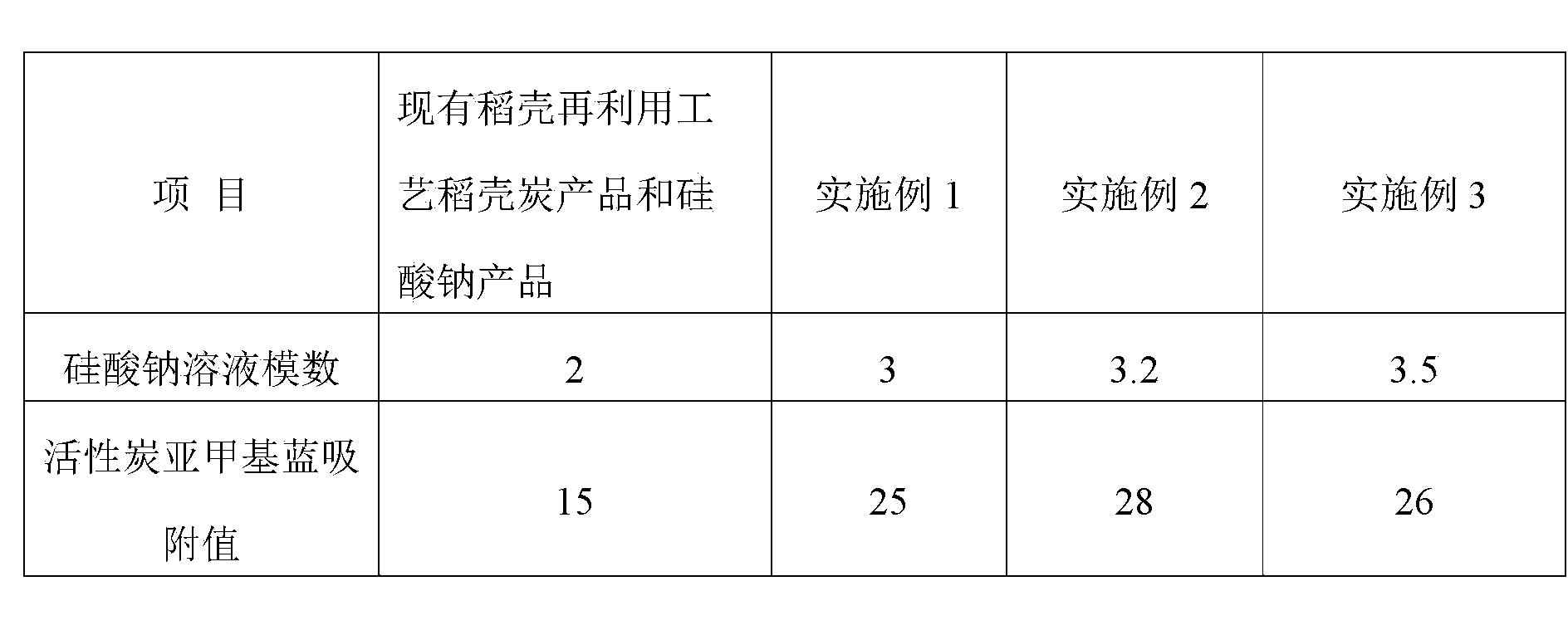Method for producing activated carbon and inorganic silicon compounds from rice hulls
A technology for producing activated carbon and rice husk charcoal, which is applied in the production of activated carbon and inorganic silicon compounds. It can solve the problems of complicated process equipment and complicated process steps, and achieve the effects of wide application range, high purity and less impurities in the product.
- Summary
- Abstract
- Description
- Claims
- Application Information
AI Technical Summary
Problems solved by technology
Method used
Image
Examples
Embodiment 1)
[0020] (1) Feed the rice husk into a pyrolysis reactor such as our company's patent CN201010583412.4, and pyrolyze it at 480°C to generate rice husk charcoal;
[0021] (2) Crushing the rice husk charcoal into rice husk charcoal particles, crushing and screening out 60-100 mesh rice husk charcoal particles;
[0022] (3) React the above-mentioned rice husk charcoal particles with the desiliconizing agent sodium carbonate at 100°C for 4 hours in a reaction kettle, and then separate them in a filtration device to obtain a sodium silicate solution with a modulus of 2~2.5 and rice husk carbonized material;
[0023] (4) Mix the rice husk carbonized material with the activator zinc chloride evenly, activate in the activation equipment, the activation temperature is 650°C, and the activation time is 2 hours;
[0024] (5) After activation, all the substances in the activation equipment are washed in the washing tank for 1 hour, and the activator and wet activated carbon are obtained aft...
Embodiment 2)
[0028] (1) Feed the rice husk into a pyrolysis reactor such as our company's patent CN201010583412.4, and pyrolyze it at 550°C to generate rice husk charcoal;
[0029] (2) Crushing the rice husk charcoal into rice husk charcoal particles, crushing and screening out 60-100 mesh rice husk charcoal particles;
[0030] (3) React the above-mentioned rice husk charcoal particles with the desiliconization agent calcium hydroxide in a reaction kettle at 105°C for 4 hours, and then separate them in a filtration device to obtain a sodium silicate solution with a modulus of 2~2.5 and rice husk charcoal material ;
[0031] (4) Mix rice husk charcoal material and activator phosphoric acid evenly, activate in the activation equipment, the activation temperature is 700°C, and the activation time is 1.5h;
[0032] (5) After activation, all the substances in the activation equipment are washed in the washing tank for 1 hour, and the activator and wet activated carbon are obtained after separa...
Embodiment 3)
[0036] (1) Feed the rice husk into a pyrolysis reactor such as our company's patent CN201010583412.4, and pyrolyze it at 600°C to generate rice husk charcoal;
[0037] (2) Crushing the rice husk charcoal into rice husk charcoal particles, crushing and screening out 60-100 mesh rice husk charcoal particles;
[0038] (3) React the above-mentioned rice husk charcoal particles with desiliconizing agent ammonia water at 110°C for 3 hours in a reaction kettle, and then separate them in a filtration device to obtain a sodium silicate solution with a modulus of 2~2.5 and rice husk carbonized material;
[0039] (4) Mix rice husk carbonized material with activator water vapor evenly, and activate in the activation equipment, the activation temperature is 780°C, and the activation time is 1h;
[0040] (5) After activation, all the substances in the activation equipment are washed in the washing tank for 1 hour, and the activator and wet activated carbon are obtained after separation. The...
PUM
 Login to View More
Login to View More Abstract
Description
Claims
Application Information
 Login to View More
Login to View More - R&D
- Intellectual Property
- Life Sciences
- Materials
- Tech Scout
- Unparalleled Data Quality
- Higher Quality Content
- 60% Fewer Hallucinations
Browse by: Latest US Patents, China's latest patents, Technical Efficacy Thesaurus, Application Domain, Technology Topic, Popular Technical Reports.
© 2025 PatSnap. All rights reserved.Legal|Privacy policy|Modern Slavery Act Transparency Statement|Sitemap|About US| Contact US: help@patsnap.com

